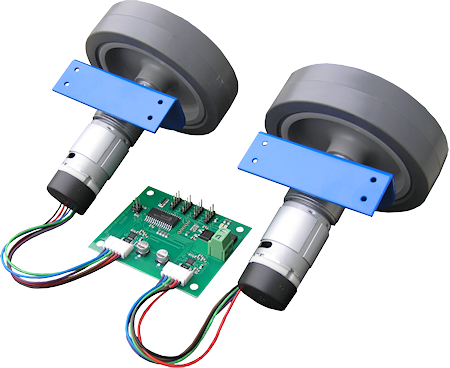Tips on Constructing Large Bases
You can scale most any base design to build a larger bot. If plans call for a 4" square base you can readily expand it to 12", 15", even 20", as long as you compensate for the size increase by using the appropriate materials.
For example, 1/8" plastic may be perfectly suitable for that 4" square base, but scaled to 12", the plastic is too thin to provide adequate support. Except perhaps for the microcontroller or other central processing electronics, everything in the robot must be scaled up accordingly: motors, battery, even the number (and complexity) of sensors.
Start with the base material. You need a thicker plastic, perhaps even sheet metal, to support the extra size and weight. Test the material you want to use by cutting it to the desired size and placing it between two blocks of wood. Use bricks or rocks to place the expected weight on the material. Remember that plastic and wood can warp over time, so look for any telltale signs of stress. Plastics like PVC exhibit something known as “cold creep,” where they become permanently warped with excessive weight and stress.
One of the most common mistakes of first-time robot builders is trying to scale up a small design without taking into consideration the need for larger and more powerful motors. A 15" triple-decker base can easily weigh 10 pounds, without motors or battery, especially if it’s constructed out of aluminum channel and angle stock.
The same R/C servo motors that propelled a 6" or 7" robot are woefully underpowered for the larger and heavier base. Not only do the motors lack the required torque, they are not designed for the weight, so they’ll either break the first time they’re used or will wear out prematurely. Too, lightweight plastic wheels that worked perfectly well on a small robot will crack, break, or sag under the added weight of a larger bot.
To compensate for the scaled size, you need to begin by selecting larger wheels and motors that are designed for the extra load. Don’t forget that bigger motors need more substantial mounting hardware, and they probably require more robust drive electronics—they consume more current, so a 1-amp motor bridge circuit probably won’t do.
Understand that larger motors, mounts, wheels, and drive circuits cost more. You may not be able to easily fabricate these yourself. Ready-made solutions, like the motor/wheel pair below, are a viable alternative to scrounging surplus shops for the bits and pieces, though either method can yield results (plus, going fishing at a surplus shop can be fun all on its own!).

[Figure 1. Photo courtesy Devantech]